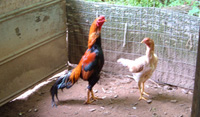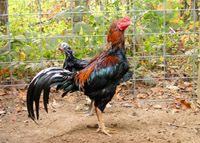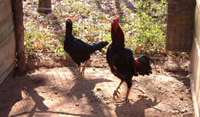|
We
have several families of thai game fowl, including the
Spangled group, the Laos-thai group, and the Double
Spur group. All of these families descended from birds
imported directly from Thailand or Laos in the early
and mid 1990s. It is important to make clear at this
point that we don't just take on a bloodline simply
because it came directly from imported stock, however.
Even in Thailand and Laos, the number of quality bloodlines
is very small compared to the number of average or poor
bloodlines. Given this fact, it is inevitable that not
all birds imported to the United States came from quality
bloodlines.
The first true thai game fowl family that we acquired
here in the United States was the Spangled Thai Family.
This family descended from a pair of birds purchased
directly from a breeder in Thailand and imported to
the United States in the very early 1990s. Although
we call it 'spangled,' about half of the birds from
this family are actually of the Leung Hang Khao variety,
which is another stereotypical thai game fowl variety.
We no longer have this bloodline in its pure form due
to problems during our transition from central California
to here in North Carolina. We lost many of our key breeders
for this family in the move and the birds produced thereafter
were never again of the same quality. This family has
since faded away, and now only a pair of old hens remain.
The three established families that we currently have
are described to the right. The laos-thai family is our
primary family of birds, as it possesses all of the attributes
that we desire in our birds. We know of very few other
families that produce birds of the quality that this family
produces. Aside from these three established families,
we also have breeding pairs of other families which we
are assessing at the moment. Of note are two feather-plucker
bloodlines that we are hoping to consolidate and propagate
within the next year or so.
Selecting Future
Stock
Today, we try our best to stay true to the original
bloodlines, breeding and selecting our stock to emphasize
the same traits or attributes that made their predecessors
so successful. We do this by selecting future breeders
that have physical features identical or very similar
to their parents. This is the reason why birds that
look like their parents (or look like a bird along their
ancestral line) are so highly valued by us, as similar
physical attributes also indicate similar genetic attributes.
Game Fowl Physical Attributes
The thai game fowl bloodlines that we have usually breed
out roosters in the 7 to 8.5 lbs range at full maturity.
We don't particularly like small birds (6.5 lbs or less),
so we've steered clear of bloodlines that tend to produce
smaller birds. We also favor birds with full plumage
and long, flowing feathers. This requirement is practical
as well as aesthetic. Winters here in North Carolina
can be quite cold, therefore birds with a denser plumage
tend to fare better than those with a thinner plumage.
Did
you know? You can show these birds
at your local poultry show! If you are interested, please
contact your local poultry club or poultry show organizer
for details. Thai game fowl and most other oriental
game fowl breeds are usually shown under the "large
fowl" category because of their size compared to
most other show type poultry. Although we ourselves
are dedicated solely to preserving the thai game fowl
breed and do not participate directly in poultry shows,
we have had several customers who have successfully
shown these birds at their local poultry shows, many
of them winning blue ribbons. Be the first to introduce
these beautiful and exotic fowls to your community by
showing them at your local poultry show!
For more information online, please
visit the following sites:
Araucana.net: http://www.araucana.net/Poultry_shows.htm
The Coop.org: http://www.the-coop.org/shows/shows.html
The American Poultry Association: http://amerpoultryassn.com/
|
|
| Laos-Thai
Family |
 This
family originated from a thai game fowl rooster that
was sought out and imported here to the United States
from Laos. The bird was bred and produced many high
quality offspring before it was sent back to its owner
in Laos. This family's key defining attribute, which
we use to gauge the purity of this family, is that it
randomly breeds out white birds. Every time two white
birds appear in the same batch, it is always a pair,
one male and one female. Today this family is our primary
family of birds and has consistently produced beautiful,
high quality birds for us. Weights for roosters in this
family range from 7.5 to 9 lbs. |
| Double
Spur Thai Family |
 This
family produces birds with either two or more spurs,
or one large, blunt spur, on each foot. As this type
of spur is very rare, this family holds a special place
on our farm. Birds from this family are usually black
with orange back and neck hackles. Some have white tails,
while some may not. Other than on their tails and wings,
they typically do not exhibit any other white colorations.
Weights for roosters in this family range from 7 to
8.5 lbs. |
| Pama-Thai
Family |
 This
family was also imported to the United States from Thailand.
It was infused with pama (burmese) game fowl blood some
time in its past. This family typically breeds out black
birds with orange or red back feathers and neck hackles,
and some exhibit speckling on the feet, wingtips, and
head. Some have white tails, while some may not. Weights
for roosters in this family range from 7 to 8.5 lbs. |
|

